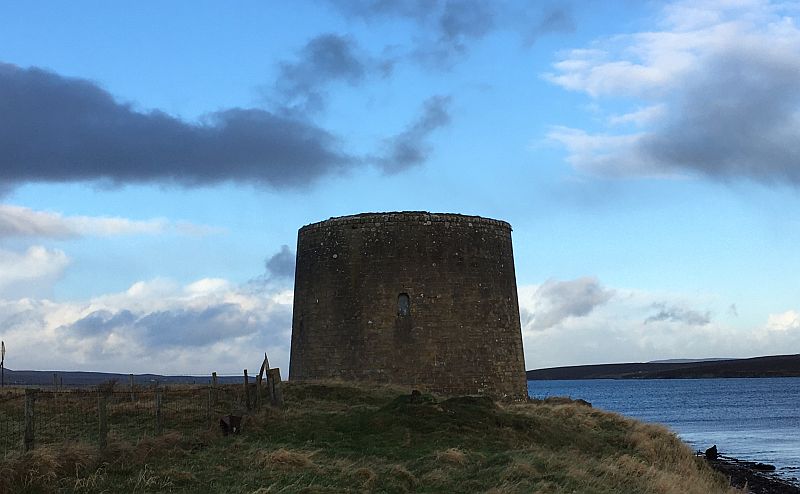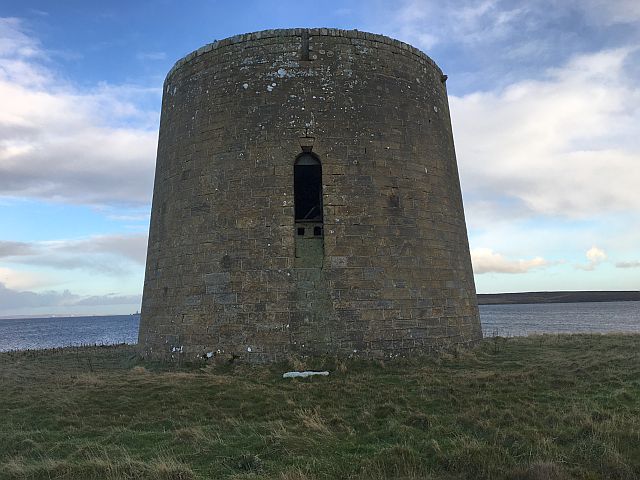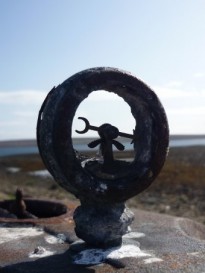The Martello Tower at Crockness in North Walls, Hoy, Orkney bears witness to the strategic importance of the island and of Scapa Flow in several wars. It stands on the shore just around from the Ruff of Crockness, near to Towerhouse, the farm name undoubtedly deriving from the monument.

Why was it built?
The tower in Crockness and its counterpart in Hackness, South Walls, were built in response to the threat to the Baltic trade from American privateers in the 1812-14 war between Britain and the USA.
The Baltic trade was important to Britain, not only because she valued every outlet for her manufactured goods and colonial produce, but because British supremacy at sea depended on naval stores (timber, pitch and hemp) from the northern countries.
Fereday, RP (1971) The Longhope Battery and Towers. Stromness, Orkney: Private publication printed by WR Rendall. p.23.
As Fereday goes on to explain, ships from west coast ports sailed north around Britain on their way to the Baltic ports rather than risk the Channel. They would wait at Longhope for a warship to convoy them across the North Sea. Convoys sailed every three weeks or so, April to October, on dates fixed by the Admiralty and widely advertised. The 40 plus ships anchored in Longhope were thus an obvious target for American privateers. Hence the decision to build a Battery to guard the entrance to Longhope with a barrack for the gunners. The map below should help with locations and the strategic importance of the anchorage. The Pentland Firth is to the south and west. More modern map.

Reproduced with the permission of the National Library of Scotland (https://maps.nls.uk/index.html)
Plans extended
By July 1813 work on the Battery at Hackness in South Walls was underway. That same month Major James Carmichael Smith, Commander of the Royal Engineers in North Britain, recommended construction of a round tower with a gun on top to defend the Battery. He advised a second Battery and Tower should be built at Crockness “with a view to the complete defence of the valuable convoys which assemble at Long Hope Sound”.1Fereday p. 27
Work on the two towers had begun by late 1813. Hoy sandstone quarried at the Bring Head and carried by boat along Scapa Flow to the beaches by both sites.2Fereday p. 29. The actual building work seems to have been carried out in late 1814 and completed by August 1815 though only a Tower was built at Crockness. The peace of Ghent was signed with the USA on 24 December 1814 and the war declared to be at an end on 14 February 1815. Thus the defences were too late, but who could have predicted the end of the war?
Description
The Towers are 10m high and 47m in circumference, with a much thicker wall on the seaward side. The entrance is about 4m above ground, on the landward side, with ladder access originally. The first floor provided living quarters for an NCO and gunners. It also gave access to the gun platform on the top of the Tower, where a wheeled gun platform carrying a 24 pound cannon was mounted, as well as to the basement where stores were kept.

Historic Environment Scotland’s Canmore site has many photos of the Crockness Martello Tower. (There are some photos of the Hackness Battery and possibly the Hackness Tower there too.)
After the 1812-14 War
The Towers and Battery remained in the ownership of the military authorities but little was done with them until a perceived threat from the American Fenian Brotherhood in the mid 1860s. Modern gun mountings were added to both Towers and considerable changes made to the Battery but they saw no action. By the early 1880s only two artillerymen were stationed at the Battery. Neither Tower was part of they system of World War One forts to defend Scapa Flow. Overall the Crockness Tower probably had a quieter life as there was no adjoining Battery and barracks.
The Hackness Martello Tower and Battery are now in the care of Historic Environment Scotland and open to visitors.
People
Until late 2020, the Hackness Battery was home to John Cload, grandson of William Cload, an artilleryman from Hemyock, Devon, stationed at Hackness. William married Mary Anderson from the neighbouring croft and after retiring from the army returned to Hackness as caretaker. The family bought the Battery from the War Department after the First World War, using the officer’s quarters as the farm house.
In North Walls, my one-place study, I have so far found one marriage with an artilleryman. Jessie Robson, North Crockness (possibly Bluerocks?), married Daniel Hollingsworth, Royal Artillery, on 5 October 1876 in Walls. They moved to the Newcastle-upon-Tyne area where she died in 1934.
More on Martello Towers
Over 100 Martello towers were built between 1804 and 1812, mainly to defend the south and east coast of England against the threat of invasion by France, then under Emperor Napoleon, with at least a further two in Wales. Only three were built in Scotland, one at Leith and these two in the parish of Walls. See https://martellotowers.co.uk
Written for the Society for One-Place Studies January 2021 prompt “Landmarks”.
Sources:
- Fereday, RP (1971) The Longhope Battery and Towers. Stromness, Orkney: Private publication printed by WR Rendall. The definitive history.
- Historic Environment Scotland. Hackness Martello Tower and Battery History.
- Historic Environment Scotland. Hoy, Crockness Martello Tower.


Very interesting, thank you
Thanks Helen, glad you enjoyed it.
Fascinating stuff and a cracking contribution to the #OnePlaceLandmarks blogging prompt!
Thanks Steve.
We have several Martello Towers along the Lake Ontario waterfront (and some built in the water) in Kingston Ontario, Canada. These were built also in response to the War of 1812 and were put back into use in the mid 1800s due to raids by American Fenians.
Thanks for taking the time to comment. I'm guessing the Ontario Martello Towers saw considerably more action than the Crockness one. (Apologies – I posted a comment some time ago rather than a reply to your comment.)
How fascinating! I'd only ever encountered Martello towers through fiction, and those were on the south coast of England. One tower features in Hidden in a Dream by Monica Edwards, one of my favourite authors in childhood and one whom I still reread with pleasure today. The tower in this book is situated on Romney Marsh, part of the Napoleonic defences you mention. In an aside, childhood reading of the novel introduced me to the flower Viper's Bugloss, which I had never seen in Scotland, and it's because of the description there that I now grow it in my garden today – much loved by bees.
Thanks for your comment. I'll need to look up the book you mention Linda – I've just Googled Viper's Bugloss too, quite a striking plant.(Apologies, I posted a comment rather than a reply some time ago, hope you didn't think I wasn't responding.)
Thanks to you all for taking the time to comment. I'm guessing the Ontario Martello Towers saw considerably more action than the Crockness one. I'll need to look up the book you mention Linda – I've just Googled Viper's Bugloss too, quite a striking plant.